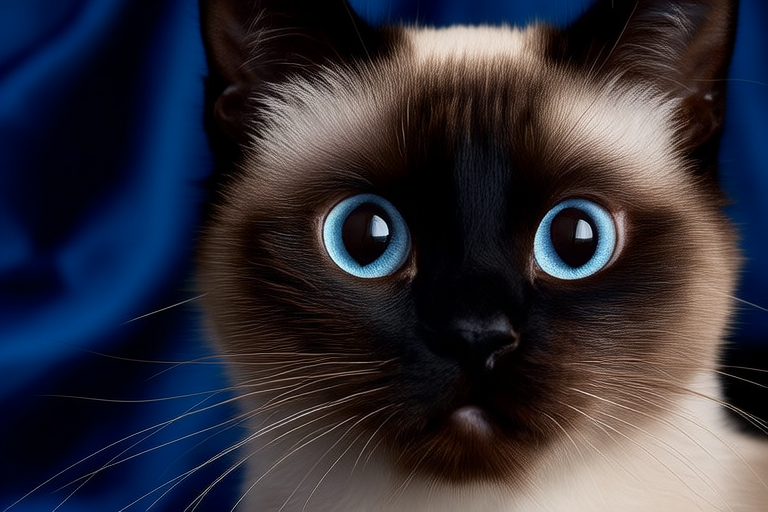Genetic Factors and Historical Background of Siamese Cats
The striking blue eyes of Siamese cats are a result of a combination of genetic factors and environmental influences. Understanding these elements provides insight into the breed’s unique characteristics and the historical context that has shaped them.
Genetic Basis of Blue Eyes
The genetic foundation of the Siamese cat’s blue eyes lies in a specific gene mutation. This mutation is linked to the temperature-sensitive albino gene, which affects the production of melanin, the pigment responsible for hair, skin, and eye color. In cooler parts of the body, such as the extremities (ears, paws, tail, and face), melanin production is higher, leading to darker points. Conversely, the warmer central areas, including the torso, remain lighter. This phenomenon, known as partial albinism, results in the characteristic contrast between the darker points and the lighter body.
Eye color is influenced by the same gene mutation. The reduced melanin production in the iris causes it to appear blue. This blue color is more pronounced when there is less melanin present, making the eyes of Siamese cats particularly striking. Scientific studies have shown that the gene responsible for this trait is recessive, meaning both parents must carry the gene for their offspring to exhibit the blue eyes and point coloration.
Temperature Influence on Coat and Eye Color
The temperature of the environment plays a crucial role in the development of coat and eye color in Siamese cats. The gene responsible for the color pattern is sensitive to temperature; it functions optimally at lower temperatures. In colder regions, the cat’s points will be darker, while in warmer climates, they may appear lighter. This temperature sensitivity also impacts the intensity of the blue eye color. Cooler environments can enhance the contrast and deepen the blue hue of the eyes, while warmer conditions might result in a lighter, less intense blue.
Historical Background and Preservation of Traits
The origins of Siamese cats can be traced back to Thailand, formerly Siam, where they were revered and kept in temples. These cats were considered sacred and were often given as royal gifts. The first recorded export of Siamese cats to Europe occurred in the late 19th century, and their unique appearance quickly gained popularity. Over time, selective breeding helped preserve the distinctive traits, including the blue eyes and point coloration.
During the 20th century, Siamese cats underwent significant changes in appearance. Early Siamese cats had a more moderate build and less extreme facial features compared to modern varieties. However, selective breeding for show standards led to the development of the contemporary Siamese, characterized by a slender body, almond-shaped eyes, and a longer, narrower head. Despite these changes, the blue eyes and point coloration remained consistent, ensuring the preservation of the breed’s signature look.
Scientific Insights and Myths
Recent scientific research has shed light on the genetic mechanisms behind the Siamese cat’s blue eyes. Studies have identified specific mutations in the TYRP1 gene, which is involved in melanin synthesis. These mutations lead to the temperature-sensitive expression of pigmentation, resulting in the distinctive coat and eye colors. Additionally, researchers have found that the blue eyes are not associated with any vision impairment, dispelling the myth that all blue-eyed cats are blind.
Contrary to popular belief, not all blue-eyed cats suffer from vision problems. While some breeds with blue eyes, like the Persian, may have a higher incidence of certain eye disorders, Siamese cats generally have good vision. Their blue eyes are a result of reduced melanin production rather than an underlying health issue.
Comparison with Other Cat Breeds
Several other cat breeds are known for their blue eyes, including the Russian Blue, Turkish Van, and Balinese. However, the Siamese stands out due to its unique combination of blue eyes and point coloration. The Russian Blue has a solid gray coat and piercing green eyes, while the Turkish Van exhibits a white body with colored markings on the head and tail. The Balinese, a long-haired version of the Siamese, shares similar physical traits but has a slightly different genetic profile. The Siamese’s distinctiveness lies in the interplay between its blue eyes and the temperature-dependent coat color.
Tips for Maintaining Eye Health
Owners of Siamese cats can take several steps to ensure the health and beauty of their pets’ eyes. Regular cleaning with a damp cloth can remove debris and prevent irritation. It is important to avoid using harsh chemicals or commercial wipes that may cause damage. Owners should also monitor their cat’s eyes for signs of redness, discharge, or excessive tearing, which could indicate an underlying issue.
Veterinary check-ups are essential for maintaining overall eye health. A professional can detect early signs of conditions like glaucoma, cataracts, or infections. Proper nutrition also plays a vital role in maintaining healthy eyes. A balanced diet rich in antioxidants, vitamins, and minerals supports ocular health. Omega-3 fatty acids, found in fish oil supplements, are particularly beneficial for maintaining the integrity of the cornea and reducing inflammation.
Cultural Significance and Allure
The cultural significance of Siamese cats extends beyond their physical beauty. In Thailand, these cats were believed to possess mystical powers and were often kept in temples. Their association with royalty and spirituality added to their allure. Today, Siamese cats are cherished for their intelligence, playful nature, and striking appearance. Their blue eyes captivate viewers and add to their mystique.
The allure of Siamese cats is further enhanced by their unique vocalizations. They are known for being very talkative, often engaging in conversations with their human companions. This vocalization, combined with their captivating blue eyes, makes them stand out among other breeds. The cultural significance and enduring appeal of Siamese cats continue to draw admirers worldwide.
